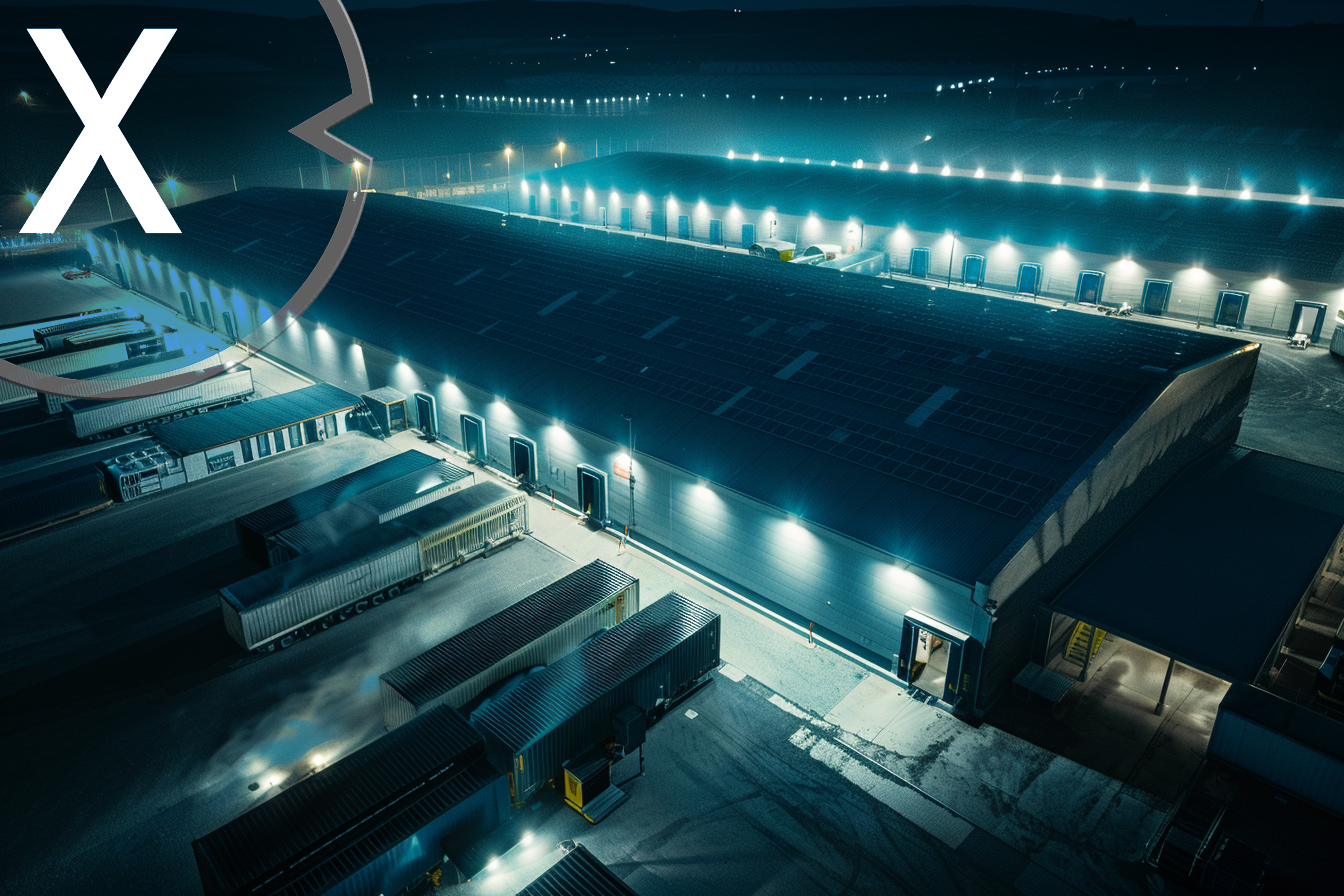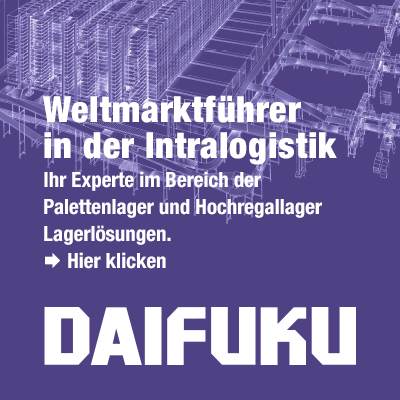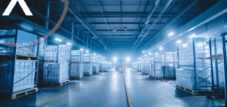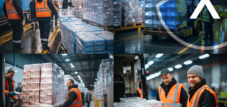Fresh logistics / refrigerated logistics: The energy concept forms the basis for the fresh storage / fresh storage and cold storage concept
Language selection 📢
Published on: October 23, 2024 / update from: October 23, 2024 - Author: Konrad Wolfenstein

The energy concept forms the basis for the fresh storage/fresh storage and cold storage – Image: Xpert.Digital
❄️🌿 The energy concept as the basis for the construction and operation of cold and fresh storage facilities
🌡️🏭 Energy optimization in fresh and cold storage: Sustainable energy solutions for warehouse cooling
The planning and operation of fresh and cold storage places high demands on the energy concept. In these special warehouses where temperature-critical goods are stored, precise control of energy flows is essential. It's not just about maintaining the required cooling performance, but also minimizing energy losses and ensuring efficient operation. A well-thought-out energy concept forms the basis for sustainable and economical fresh and refrigerated logistics. It helps reduce operating costs, minimize environmental impact while ensuring product quality.
When planning a cold storage or fresh storage facility, we analyze where energy is lost, how heat can penetrate the building and whether there is unused energy potential. On this basis, measures are developed to address these potential vulnerabilities and ensure efficient use of energy.
🔍 Energetic criteria in focus
When planning an energy-efficient cold storage facility, there are various energy criteria that play a central role. These are closely interlinked and influence both the operating costs and the environmental balance of the system. The most important factors include power consumption, transmission load, heat input and carbon footprint.
Power consumption
More than 70% of the total energy requirement of a cold storage hall comes from the cooling itself. In addition, there is the energy consumption for lighting, office use or the operation of devices. Due to this high proportion, it is crucial to keep electricity consumption as low as possible through appropriate measures. The use of modern building technology and structural adjustments can open up significant savings potential. For example, the use of LED lighting systems, the integration of motion detectors and the increased use of energy-efficient devices can significantly reduce overall electricity consumption. Another option is to use renewable energies, for example through the use of photovoltaic systems, which can partially or even completely supply the system with its own electricity.
Transmission load
The so-called transmission load describes the energy losses that occur through structural weak points such as joints, connections, walls, the roof or the floor. These points allow cold to escape from the warehouse while at the same time heat from outside enters. It is therefore important, especially in cold storage halls, to ensure high-quality insulation and sealing. Modern, standard prefabricated components offer a major advantage here. These components are specially developed for use in cold storage halls and minimize transmission losses right from the start. Even in the planning phase, architects and engineers must ensure that all connection points and transitions are optimally insulated to prevent unnecessary energy losses.
Heat input
The heat input into a cold storage hall can be caused by various factors. People who spend time in the hall bring in body heat. Additional heat can also be released by the lighting and the goods stored in the hall. Machines and devices that are operated in the cold storage hall also contribute to warming the environment. In order to minimize heat input, well thought-out space and usage planning is essential. Highly frequented areas in which people and machines work should, if possible, be separated from the most sensitive storage areas. The choice of lighting can also play a role: energy-saving LED lights have the advantage that they emit significantly less heat compared to conventional incandescent or halogen lamps.
Carbon footprint
In times of climate change and stricter environmental protection regulations, the CO2 footprint of cold storage facilities is also playing an increasingly important role. To make an active contribution to CO2 reduction, it is advisable to rely on environmentally friendly technologies. This includes the use of refrigeration systems with natural refrigerants, which are much more climate-friendly than synthetic refrigerants. In addition, the waste heat generated during refrigeration can be used sensibly. This waste heat can be used, for example, to heat offices or for other processes that require heat. Integrating a photovoltaic system on the roof of the cold storage hall can also help to significantly reduce the CO2 footprint by allowing the hall to generate part of the electricity required itself.
🏗️ Structural measures to improve energy efficiency
A key aspect of the energetically efficient operation of a cold storage hall are structural measures that reduce energy consumption right from the start. This primarily includes choosing the right building materials. Insulated panels that have a high thermal insulation value should be used for walls, roofs and floors. These materials prevent heat from penetrating into the hall from outside or cold from being released outside. Another point is the sealing of the joints and connections. Special sealants can be used here to ensure complete sealing. Automatic door systems that only open when absolutely necessary also help to minimize energy loss.
Efficient space planning is also crucial. The refrigerated area should be designed so that warm zones where there is a lot of movement are separated from the areas where goods are stored at low temperatures. This separation allows energy consumption to be significantly reduced because less cold is lost and the refrigeration systems do not have to work as hard.
🌐 Technological innovations for more sustainability
In addition to the structural measures, there are also numerous technological innovations that help reduce energy consumption in cold storage halls. For example, modern refrigeration systems that work with natural refrigerants such as ammonia or carbon dioxide are particularly efficient and environmentally friendly. These refrigerants have a significantly lower greenhouse effect compared to conventional refrigerants and therefore actively contribute to reducing CO2 emissions.
Digitalization is also playing an increasingly important role in fresh and refrigerated logistics. Smart control systems make it possible to monitor and optimize the energy consumption of the cold storage hall in real time. Sensors can be used to accurately measure the temperature in the different areas of the hall and adjust it if necessary. The electricity consumption of the refrigeration systems can also be optimized in this way. By using machine learning and artificial intelligence, these systems can also learn when and where energy consumption is highest and make adjustments accordingly to reduce overall energy consumption.
👷♀️ The role of employees in energy management
In addition to the technological and structural measures, the employees in a cold storage or fresh storage facility also play an important role in energy management. A conscious use of resources can make a significant contribution to reducing energy consumption. Employees should be trained on how to open the cold room doors as rarely and only briefly as possible in order to minimize heat loss. The economical use of lighting and machines can also have a positive impact on energy consumption. Regular training and awareness-raising measures can raise employees' awareness of the economical use of energy.
📝 Energy concept for fresh and cold storage
An efficient energy concept is essential for the operation of fresh and cold storage facilities. Through a combination of structural measures, technological innovations and a conscious use of energy, energy consumption can be significantly reduced and the CO2 footprint minimized. This not only helps reduce operating costs, but also makes an important contribution to environmental protection. Companies that invest in these technologies and concepts are better positioned in the long term and can design their warehouse logistics sustainably and efficiently.
📣 Similar topics
- ❄️ Energy efficiency for cold and fresh storage
- ⚡️ Reduce electricity consumption: strategies and measures
- 🧊 Minimize transmission losses: insulation and sealing
- 🌡️ Control heat input: Optimal room planning
- 🌍 Reduce CO2 footprint: Sustainable technologies
- 🏗️ Structural innovations for optimal energy efficiency
- 💡 Technological advances for sustainable logistics
- 👷♂️ The important role of employees in energy management
- 🔍 Analysis and planning: Detect and correct energy losses
- 📈 Future of refrigeration technology: Digital and efficient
#️⃣ Hashtags: #energyefficiency #cold halls #sustainability #CO2reduction #innovations
Xpert partner in warehouse planning and construction
We are there for you - advice - planning - implementation - project management
☑️ Smart City & Factory: Industry expert for energetic 5G buildings and halls as well as advice and installation of solar systems
☑️ Xpert.Plus - logistics consulting and logistics optimization
☑️ Industry expert, here with his own Xpert.Digital Industry Hub with over 2,500 specialist articles
I would be happy to serve as your personal advisor.
You can contact me by filling out the contact form below or simply call me on +49 89 89 674 804 (Munich) .
I'm looking forward to our joint project.
Xpert.Digital - Konrad Wolfenstein
Xpert.Digital is a hub for industry with a focus on digitalization, mechanical engineering, logistics/intralogistics and photovoltaics.
With our 360° business development solution, we support well-known companies from new business to after sales.
Market intelligence, smarketing, marketing automation, content development, PR, mail campaigns, personalized social media and lead nurturing are part of our digital tools.
You can find out more at: www.xpert.digital - www.xpert.solar - www.xpert.plus

























